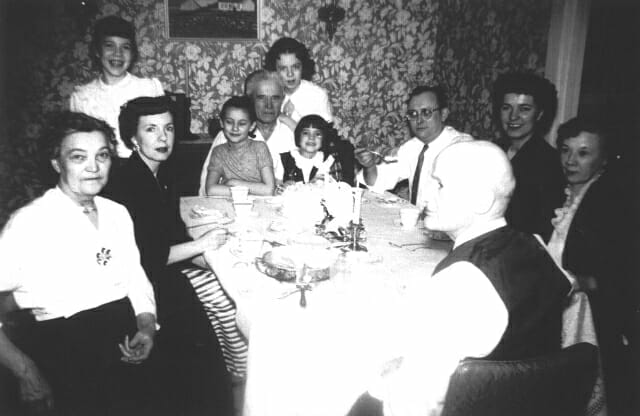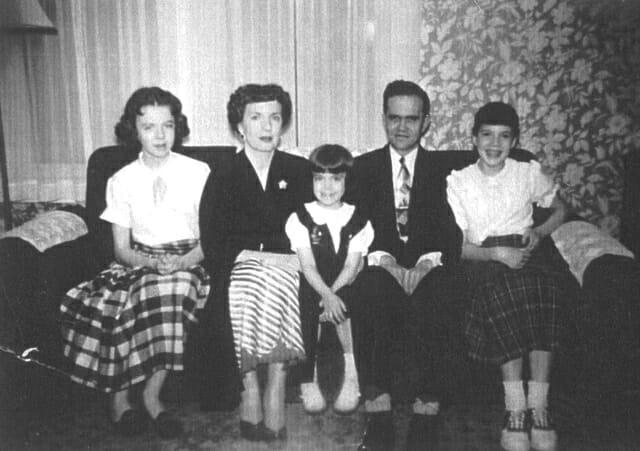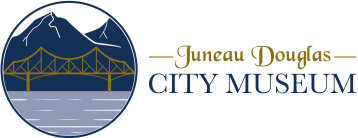Gastineau Channel Memories
Alstead, Bert
Karleen Alstead Grummett
I was born in Juneau on September 14, 1941, two months before Pearl Harbor and the ensuing World War. I was one of three girls born to Eulalia ?Pat? Archer and Karl Alstead. Mom came to Juneau during the Depression from Oregon to live with her father?s sister, her Aunt Opal and Uncle Bill Douglas and she subsequently met my Dad. He was born in Tacoma, Washington to Norwegian immigrants, Gina and Bert Alstead (changed formally from Alvestad in 1942).
Gina came to Tacoma from Norway to marry Bert Alstead. They had been young sweethearts, and he told me that when he left her in Norway, he wept. But it was three years before he could send for her. The daughter of an itinerant minister who traveled the fjords of Norway, she was 18 when they were married. Her sister, Anna, married Pete Hildre and formed that Scandinavian family unit in Juneau, as well.
My grandfather brought his small family to Juneau in 1918, during World War I to take over a fishing vessel from his brother. When they arrived on a steamship in Juneau, Grandma said she took one look at the rainy, dark, dreary day and told Grandpa she was going right back to Tacoma. But as she said, they stayed. Until his retirement many years later, he fished halibut on his boat the F/V Thelma. Grandmother was a housewife, and they lived in one of the former Kennedy Street mine workers? houses above the Chicken Yard just off of Starr Hill.
Grandma lost several children, and one, Christine, to the 1918 influenza epidemic. Dad?s only surviving sibling was my Aunt Judy. She married W.L. ?Bud? Nance and together they ran the Five and Dime Store on Front Street for many years, and also the future Juneau Drug Store and Totem Gift Shop. They had one daughter, Lorraine.
Grandma?s home was warm and inviting with an oil stove in the living room, a bowl of bread rising next to it and signs of Norwegian handicrafts all around. We spent many hours near the warmth of that stove while she taught Margie and me how to knit. One of Grandma?s favorite stories was the time they discovered smoke in their home. It was during prohibition and they had beer brewing in a crock. When the firemen came through the house to attend to the smoke, Grandma stood in front of the crock holding her skirt out to either side to hide the still. The firemen never suspected a thing.
Grandma and Grandpa were both musical. Grandpa enjoyed sitting in his wing-back chair, puffing his pipe, listening to classical music at the radio every Sunday. We were ?hooshed? if Margie and I became too noisy. In earlier years, my grandparents rolled back the carpet and provided musical gatherings for young fishermen and
friends. Grandpa played violin and Grandma guitar with their neighbor Mrs. Knute Hildre, who played piano.
During my youth I thought all grandparents sounded like mine, whose words were spoken with heavy accents. I discovered later, when my Mother?s mother came to Juneau for the birth of my younger sister Mary, in 1949, that wasn?t the case. I still strongly relate foreign accents to my grandparents, who provided profound support to me and to my sisters. They were good people who lived long and full lives in their adopted community while supporting its activities such as the Elks Club, where Grandpa enjoyed playing cards with his cronies, and the Resurrection Lutheran Church, whose lectern Bible bears their names as donors.
My parents, Pat and Karl, met in high school where he was yell king and played the tuba, and she created dance programs and other art work. He boxed groceries at Behrends Department Store and Mom waited tables at Percy?s Caf?. Before she married Dad, Shell Simmons, the future partner with Ben Benecke in Alaska Coastal Airlines, took her up in his plane doing barrel rolls ?just to hear me scream,? she said. And also to get her to say yes to a date. He helped my parents elope by flying the wedding party to Taku Lodge, and they remained lifelong friends.
After a few years of living in a miner?s house farther down Kennedy Street from Grandma and Grandpa, Mom and Dad moved to a two story apartment building on Gold Street across from St. Ann?s Hospital and kitty-corner from the teacherage on Sixth Street. We lived above another well known Juneau family, the Doogans. Mom was a housewife who sewed our clothes, as well as her own, and school costumes. She belonged to one of the many sewing clubs popular at that time. She also took us on picnics and berry picking excursions, typed for a poet, and created wonderful winter window decorations for various Juneau businesses during the Christmas holidays. She received many first prizes for her efforts.
Margie and I viewed much of neighborhood life from our upstairs windows. I often watched the nuns walking briskly back and forth between the Cathedral of the Nativity and St. Anns, through the hospital?s lawn and vegetable and flower gardens. Once in a while a neighbor boy, Ricky Smith, threw rocks at the crab apple trees so the apples would fall on the street side of the fence. But the groundskeeper, who always seemed to lie in wait, came at us with arms waving, yelling at Rick?s attempts. The church bell peeled from the steeple on a regular basis.
The view from the south windows overlooked the Russian Orthodox Church, downtown and the Channel before the Mendenhall Apartments were built on Fourth Street in the early 1950?s, blocking our view. Those front windows also provided an eye view of the memorable pulp mill fire, and we watched as large pieces of ash floated over the house. We also ducked when the fighter squadron of P51s that came through Juneau one year flew over town several times and seemingly right at those front windows.
Wood planked sidewalks lined the gravel hills and cross streets. Every foot or so, raised wood pieces were attached to one of the planks to catch descending heels on the steep hills during icy winter conditions. These same hills were roped off for sledding in the winter. The best ride was getting a good start at Seventh Street and sailing down all the Gold Street hills to Second Street yelling ?Clear the track!? The momentum gained sent sledders part way up Gastineau Avenue on the other end. When the streets were paved in the early 50?s, we roller skated right down the middle of the smooth streets. Biking was much easier, too.
Our family didn?t own a car until after I?d left for college, so one of my favorite happenings was when my Uncle Bud and/or Aunt Judy would stop by in their Willie?s Jeep to take us for a ride ?out the road.? They not only took us, but any number of kids we were playing with at the time. Aunt Judy often took us swimming at Lena Beach, and I admired the way she would swim far out and then float and let the tide take her back to shore. She also took us on winter, moonlit nights to ice skate on Auke Lake?s dark ice near a bonfire burning on shore.
Our home was very centrally located. It was a block from the then Federal Building, with its busy post office and the Territorial museum upstairs. It was also just a block from the grade and high schools and one block up and one west to the steep steps and narrow path leading down to the Evergreen Bowl where two pools, tennis courts, picnic tables and covered play area were located. I learned to swim there in the small pool. In order to swim in the ?big? pool you were required to swim the width of it. Brownie Day Camp was held every summer in the Bowl, as well as end of school and summer church picnics.
On rainy days we often signed ourselves into the hushed museum where, under the watchful eye of the curator, Mr. Keithahn, we marveled at all the mysterious sights. These included the figure of President Lincoln in his top hat sculpted from a log, the many stuffed animals-most especially the bear-and the bright blue trade beads and other native artifacts laying in glass cases.
We also walked to the new Juneau Memorial Library (now the City Museum) where Dale DeArmond helped us find books to read. Before that, the library was housed across the street upstairs in the old City Hall where the kindly, white-haired librarian greeted my mother, Margie and me at story hour. The best part of story hour, though, was afterwards when one of the firemen would slide down the brass pole for us.
Margie and I always looked forward to Dad?s return from his long absences on the sea. When we were young, if the fishing season was successful, he brought home gifts. Mom always got a ?heads-up? that Dad?s boat was headed into town from the local phone operator who, atop ?Telephone Hill,? commanded a straight-on view of Gastineau Channel. Hearing this exciting news we waited seemingly endlessly until the boat had tied up, unloaded fish at the Cold Storage and Dad finally made it home, lugging his nap sack over his shoulder. Sometimes we dressed up and walked to town past Tlingit women selling moccasins and other crafts, past the noisy, fishy-smelling Cold Storage, and towards the City Dock to meet Dad?s boat. We didn?t care about his crusty beard or the creosote and fish smell emanating from him. We were just grateful to have him home. It took one harrowing trip through the Gulf of Alaska before he decided to give up fishing. Mom must have been pleased, for she was primarily a single parent most of the time due to Dad?s long absences, because in those days, when fishing was so good, boats could be out for months at a time. Dad usually came home on the one day the fleet didn?t fish, July 4, which was also his birthday.
In 1955, local town life as we knew it changed when our family moved to a new prefabricated home of our own on Glacier Avenue. That year I attended 8th grade at Mt. Jumbo School in Douglas, part of the new school district consolidation efforts. In 1958, the new high school opened on Glacier Avenue, just a few yards from our home. Prior to that, we walked to the old high school in town. In high school, I enjoyed several traditional activities including the school rally for the first basketball game of the season with a snake dance of students through town and ending in the Evergreen Bowl with a bonfire. I enjoyed participating in choir and with the J-Bird staff and led the Pep Club Drill Team my senior year. Many of us attended the almost weekly school dances with music from a jukebox. A favorite tradition was Senior Sneak day when the seniors picked a day and place before graduation, to play hooky, with the sanction of the administration. I graduated in 1960, in a class of 79, the last one of under 100 students.
I enjoyed high school, forming many friendships that last to today. Those included my future husband, Roger Grummett, whom I met on those bus rides to and from eighth grade in Douglas and for whose team, the ?Vampires,? coached by Mr. Bill Overstreet, I was one of three cheerleaders. The other two were Kay Ghiglione, whose father was construction engineer for the old Douglas Bridge, and Kay Dilg, whose mother Belle, ran Belle?s Caf? for many years. Roger?s father, Stanley Grummett, came to Juneau to work for the mine and to play on their baseball team, and who, in 1933, managed an agency that was to become the Grummett Insurance Agency.
Dad fished with my Grandpa Bert until the 1950?s, when he attended school in Washington to receive his master-engineer license. He ran the M/V Grizzly Bear for the Fish and Wildlife Service until his death in 1967. Grandma followed in 1968, and Grandpa in 1972.
When my younger sister, Mary, began school, Mom went to work for the Bureau of Indian Affairs, eventually becoming secretary to various directors. She remarried after my father?s death to Claude Rogers, who was a former bush pilot and road engineer for the federal government. She retired and moved with him to Anchorage and split her time between that town and Yuma, Arizona, until her death in 1991.
My cousin, Lorraine Nance, married Roger Boyden and they became parents of a daughter, Wendy. Tragically, Roger died in a diving accident on Twin Lakes when Wendy was very young. Lorraine?s father, Bud, died January 1994, and her mother, Judy, in April 1999. Lorraine married John Lichelot in 1998, in Austin, Texas, where they now reside.
My sister Margie married Air Force Captain Dale Shackelford after meeting him in Brindisi, Italy, where she taught for the U.S. Department of Defense. They settled in his hometown of Fresno, California, where they raised two children, David and Gina. After his early death, she returned to teaching elementary school there.
My sister Mary married Bob Carlton of Yakima, Washington, a widower with three young children, Kristi, Flint, and Shawn. She has worked there for two churches and more recently a health care agency. They now divide their time between Yakima and Yuma, Arizona.
In 2000, Roger and I celebrated 36 years of marriage and living, working and volunteering in this wonderful community our families served so well. We?ve raised two children, John and Stacy, who?ve given us three grandchildren, Jack, George and Mitchell. Like their forebears, our children work and reside in Juneau.
 |
|
 |
Margie, Pat, Mary, Karl and Karleen Alstead, 1954. |
